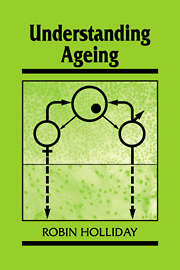Book contents
- Frontmatter
- Contents
- Preface
- Author's note
- Acknowledgements
- 1 Introduction
- 2 The evolved anatomical and physiological design of mammals
- 3 Maintenance of the adult organism
- 4 Theories of ageing
- 5 Cellular ageing
- 6 Genetic programmes for ageing
- 7 The evolution of longevity
- 8 Human disease and ageing
- 9 A better understanding of ageing
- Notes
- References
- Author index
- Subject index
9 - A better understanding of ageing
Published online by Cambridge University Press: 31 March 2010
- Frontmatter
- Contents
- Preface
- Author's note
- Acknowledgements
- 1 Introduction
- 2 The evolved anatomical and physiological design of mammals
- 3 Maintenance of the adult organism
- 4 Theories of ageing
- 5 Cellular ageing
- 6 Genetic programmes for ageing
- 7 The evolution of longevity
- 8 Human disease and ageing
- 9 A better understanding of ageing
- Notes
- References
- Author index
- Subject index
Summary
It is indeed remarkable that after the seemingly miraculous feat of morphogenesis a complex metazoan should be unable to perform the much simpler task of merely maintaining what is already formed.
– George C. WilliamsAGEING AND DARWINISM
The above quotation by Williams pinpoints the fundamental issue, which is discussed in previous chapters, and the answer takes us a long way towards a basic understanding of ageing. As in so much of biology, the explanation for ageing can only be found in its evolutionary origins. The universal feature of living organisms is their ability to reproduce. For reproduction to be effective many more offspring are produced than in an ideal environment would be necessary to replace parents. The natural environment is never ideal: there is competition between species for resources, especially food. There is the ever-present competition between complex organisms and less complex parasites and pathogens. There is competition between plants and animals, especially the synthesis of toxic products in plants by secondary metabolism. A similar chemical warfare is common between small invertebrates, such as insects, and their predators. As well as competition between species, there is competition between members of the same species. All this was recognised by Darwin, and forms the basis of his theory of natural selection. In a competitive world, the best-adapted individuals are more likely to survive than the less well adapted. Fitness, in the terminology of the population geneticist, is the likelihood of producing offspring that will themselves produce offspring.
- Type
- Chapter
- Information
- Understanding Ageing , pp. 139 - 152Publisher: Cambridge University PressPrint publication year: 1995



